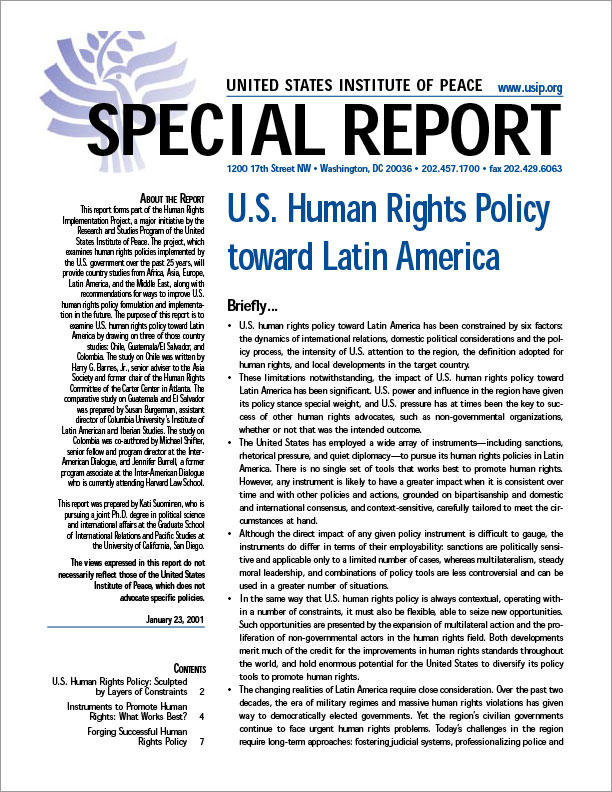
Summary
- U.S. human rights policy toward Latin America has been constrained by six factors: the dynamics of international relations, domestic political considerations and the policy process, the intensity of U.S. attention to the region, the definition adopted for human rights, and local developments in the target country.
- These limitations notwithstanding, the impact of U.S. human rights policy toward Latin America has been significant. U.S. power and influence in the region have given its policy stance special weight, and U.S. pressure has at times been the key to success of other human rights advocates, such as non-governmental organizations, whether or not that was the intended outcome.
- The United States has employed a wide array of instruments--including sanctions, rhetorical pressure, and quiet diplomacy--to pursue its human rights policies in Latin America. There is no single set of tools that works best to promote human Rights. However, any instrument is likely to have a greater impact when it is consistent over time and with other policies and actions, grounded on bipartisanship and domestic and international consensus, and context-sensitive, carefully tailored to meet the circumstances at hand.
- Although the direct impact of any given policy instrument is difficult to gauge, the instruments do differ in terms of their employability: sanctions are politically sensitive and applicable only to a limited number of cases, whereas multilateralism, steady moral leadership, and combinations of policy tools are less controversial and can be used in a greater number of situations.
- In the same way that U.S. human rights policy is always contextual, operating within a number of constraints, it must also be flexible, able to seize new opportunities. Such opportunities are presented by the expansion of multilateral action and the proliferation of non-governmental actors in the human rights field. Both developments merit much of the credit for the improvements in human rights standards throughout the world, and hold enormous potential for the United States to diversify its policy tools to promote human Rights.
- The changing realities of Latin America require close consideration. Over the past two decades, the era of military regimes and massive human rights violations has given way to democratically elected governments. Yet the region's civilian governments continue to face urgent human rights problems. Today's challenges in the region require long-term approaches: fostering judicial systems, professionalizing police and armed forces, building vibrant civil societies, and strengthening inter-American and international institutions working on human rights.
About the Report
This report forms part of the Human Rights Implementation Project, a major initiative by the Research and Studies Program of the United States Institute of Peace. The project, which examines human rights policies implemented by the U.S. government over the past 25 years, will provide country studies from Africa, Asia, Europe, Latin America, and the Middle East, along with recommendations for ways to improve U.S. human rights policy formulation and implementation in the future. The purpose of this report is to examine U.S. human rights policy toward Latin America by drawing on three of those country studies: Chile, Guatemala/El Salvador, and Colombia. The study on Chile was written by Harry G. Barnes, Jr., senior adviser to the Asia Society and former chair of the Human Rights Committee of the Carter Center in Atlanta. The comparative study on Guatemala and El Salvador was prepared by Susan Burgerman, assistant director of Columbia University's Institute of Latin American and Iberian Studies. The study on Colombia was co-authored by Michael Shifter, senior fellow and program director at the Inter-American Dialogue, and Jennifer Burrell, a former program associate at the Inter-American Dialogue who is currently attending Harvard Law School.
This report was prepared by Kati Suominen, who is pursuing a joint Ph.D. degree in political science and international affairs at the Graduate School of International Relations and Pacific Studies at the University of California, San Diego.
The views expressed in this report do not necessarily reflect those of the United States Institute of Peace, which does not advocate specific policies.